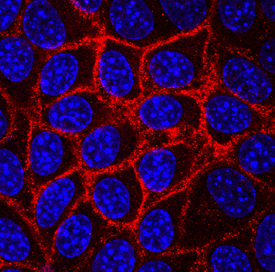Mouse Syndecan-1/CD138 Antibody Summary
Gln18-Glu252
Accession # P18828
Applications
Please Note: Optimal dilutions should be determined by each laboratory for each application. General Protocols are available in the Technical Information section on our website.
Scientific Data
 View Larger
View Larger
Syndecan‑1/CD138 in NMuMG Mouse Cell Line. Syndecan-1/CD138 was detected in immersion fixed NMuMG mouse mammary gland epithelial cell line using Rat Anti-Mouse Syndecan-1/CD138 Monoclonal Antibody (Catalog # MAB2966) at 10 µg/mL for 3 hours at room temperature. Cells were stained using the NorthernLights™ 557-conjugated Anti-Rat IgG Secondary Antibody (red; Catalog # NL013) and counterstained with DAPI (blue). Specific staining was localized to cell surfaces. View our protocol for Fluorescent ICC Staining of Cells on Coverslips.
Reconstitution Calculator
Preparation and Storage
- 12 months from date of receipt, -20 to -70 °C as supplied.
- 1 month, 2 to 8 °C under sterile conditions after reconstitution.
- 6 months, -20 to -70 °C under sterile conditions after reconstitution.
Background: Syndecan-1/CD138
Syndecan-1, designated CD138, is a dimeric type I transmembrane (TM) protein that belongs to the Syndecan family of Type 1 transmembrane proteins (1, 2). The four Syndecan family members are major carriers of heparan sulfate (HS) and chondroitin sulfate glycosaminoglycans (GAGs) that have different expression patterns and extracellular sequences. Syndecan-1 forms weak non-covalent homodimers, or heterodimers with Syndecan-2 or -3, through interactions of the transmembrane domain (3). It is synthesized as a 310 amino acid (aa) precursor with a 22 aa signal sequence, a 233 aa extracellular domain (ECD) that includes three closely spaced consensus Ser-Gly HS attachment sites near the N-terminus, a 21 aa TM segment, and a 35 aa cytoplasmic region that includes a PDZ binding motif with a tyrosine phosphorylation site (4). The ECD is variably modified by GAGs, producing molecular weights of 120‑200 kDa for native Syndecan-1. Soluble forms are shed via proteolytic cleavage. Mouse Syndecan-1 ECD shares 70% and 87% aa identity with the ECD of human and rat Syndecan-1, respectively. Alternative splicing in mouse generates an isoform with an internal deletion of 44 aa from the ECD (5). Syndecan-1 shows highest expression on epithelial cells such as keratinocytes, and terminally differentiated B cells such as plasma cells (6, 7). It aids wound healing in skin, cornea, and heart following myocardial infarction by promoting re-epithelialization, migration, and collagen deposition (6‑10). It binds chemokines, creating chemotactic gradients when shed, but also binds and modulates integrins to control the influx of leukocytes (7, 9, 11). The net effect is to allow, but limit, inflammation. In myeloma and other cancers, shedding of Syndecan-1 can facilitate growth, angiogenesis and metastasis (12‑14). Growth factors, such as FGFs and HGF, bind GAG chains and use Syndecan-1 as a coreceptor (14, 15). The GAG chains may also be used by a variety of viruses and bacteria for cell adhesion and uptake (6).
- Tkachenko, E. et al. (2005) Circ. Res. 96:488.
- Mali, M. et al. (1990) J. Biol. Chem. 265:6884.
- Dews, I.C. and K.R. MacKenzie (2007) Proc. Natl. Acad. Sci. USA 104:20782.
- Saunders, S. et al. (1989) J. Cell Biol. 108:1547.
- Romaris, M. et al. (1999) J. Biol. Chem. 274:18667.
- Fears, C.Y. and A. Woods (2006) Matrix Biol. 25:443.
- Stepp, M.A. et al. (2002) J. Cell Sci. 115:4517.
- Ojeh, N. et al. (2008) J. Invest. Dermatol. 128:26.
- Stepp, M.A. et al. (2007) J. Cell Sci. 120:2851.
- Vanhoutte, D. et al. (2007) Circulation 115:475.
- Li, Q. et al. (2002) Cell 111:635.
- Beauvais, D.M. et al. (2009) J. Exp. Med. 206:691.
- Yang, Y. et al. (2007) J. Biol. Chem. 282:13326.
- Derksen, P.W.B. et al. (2002) Blood 99:1405.
- Su, G. et al. (2007) J. Biol. Chem. 282:14906.
Product Datasheets
Citations for Mouse Syndecan-1/CD138 Antibody
R&D Systems personnel manually curate a database that contains references using R&D Systems products. The data collected includes not only links to publications in PubMed, but also provides information about sample types, species, and experimental conditions.
2
Citations: Showing 1 - 2
Filter your results:
Filter by:
-
GLIPR1 expression is reduced in multiple myeloma but is not a tumour suppressor in mice
Authors: N Friend, JE Noll, KS Opperman, KC Clark, KM Mrozik, K Vandyke, DR Hewett, ACW Zannettino
PLoS ONE, 2020-01-29;15(1):e0228408.
Species: Mouse
Sample Types: Whole Cells
Applications: Flow Cytometry -
Syndecan-1 in the mouse parietal peritoneum microcirculation in inflammation.
Authors: Kowalewska P, Patrick A, Fox-Robichaud A
PLoS ONE, 2014-09-03;9(9):e104537.
Species: Mouse
Sample Types: In Vivo
Applications: IHC-Fr
FAQs
No product specific FAQs exist for this product, however you may
View all Antibody FAQsReviews for Mouse Syndecan-1/CD138 Antibody
There are currently no reviews for this product. Be the first to review Mouse Syndecan-1/CD138 Antibody and earn rewards!
Have you used Mouse Syndecan-1/CD138 Antibody?
Submit a review and receive an Amazon gift card.
$25/€18/£15/$25CAN/¥75 Yuan/¥2500 Yen for a review with an image
$10/€7/£6/$10 CAD/¥70 Yuan/¥1110 Yen for a review without an image







